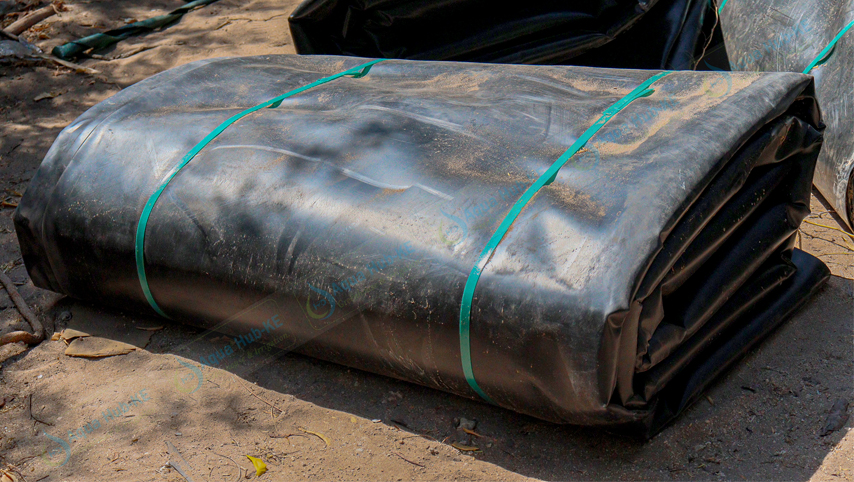Quality dam liners for storing irrigation water are available at our shops and orders to all parts of Kenya.
Dam Liners for Sale in Kenya
We stock dam liners of different gauge sizes, ranging from 0.3 mm to 1 mm, all suitable for storing irrigation water and water waste management.
Call : +254790719020
What is the Dam Liner Technical Data?
- Black High-Density Polyethylene materials
- Hard to enhance durability.
- Flexible surface which makes the placement easy and reliable.
- They are in thickness sizes of 300, 500, 750, and 1000 microns
How much are Dam Liners in Kenya?
The cost of Dam Liners at Aqua Hub Kenya depends on the thickness sizes available. Our pricing per square meter is; KES 150 for 0.3mm, 230 for 0.5mm, 340 for 0.75mm, and 450 for 1 mm size.
Call : +254790719020
Dam Liners for Irrigation: Why Dam Liners are Becoming Popular in Kenya

The rising reliance on irrigation has made the use of dam liners popular in Kenya and large parts of Africa. Climatic conditions in Kenya are increasingly becoming unfavorable leaving large land arable land dry and unsuitable for farming.
Through our waterproof dam liners, water pans are becoming reliable for availing water for agriculture and domestic use.
Dam Liners: How to Utilize Rainwater for Irrigation Farming
You should first research the best place to build your water pan on your farm or area near the farm. Excavate the area to obtain a desirable size of the dam and acquire an appropriate dam liner to apply. Aqua Hub Kenya will assist you in the right liner to use and also help place it well on your excavation. Once installation is complete, collect water and install drip or sprinkler irrigation systems to supply water to the farm.
Rainwater should not be left to fall directly onto the dam to prevent silt or sediment from filling. It’s rather good to construct a roofing structure to cover the dam and collect water using gutters to store in the reservoir.
Dam Lining in Kenya: How Effective are Dam Liners in Agriculture?
Dam Liners are waterproof materials that counteract seepage to the ground surface and make your water pool available. Harvesting of rainwater is more effective unlike rainwater collection in tanks and concrete tanks.
Concrete tanks can leak eventually with time due to cracks in the brickwork. Plastic tanks are also not very reliable for collecting rainwater due to their small capacity and high cost of purchase.
5 Steps of Dam Lining Process
We use a step-by-step procedure to fit and install dam liners on your water pans as per the type of your reservoir.
- Step 1 : Research and Consultation – Do research either by asking farmers who have implemented dam liners or online research. Consult the experts (Aqua Hub : 0790719020)
- Step 2 : Site Visit – After consultation and agreement with us, you need to facilitate for a site visit to conduct analysis on suitability and measurement of your dam.
- Step 3 : Purchase and Delivery of Dam Liner – Make payments for the material.
- Step 4 : Installation of the liner – the actual laying and installation of the liner takes place.
- Step 5 : Testing and Inspection – We complete the project by conducting an inspection and checking for quality assurance.
How are Dam Liners Placed?
Dam liners should match your water pan in size, suitability, and flexibility to solve the water challenge on your farm. Choose the best dam liner for your reservoir by engaging with Aqua Hub Kenya. We help you calculate the suitable size through our expertise.
Prepare your dam for placement of the liner by removing rocks, and sharp roots and making the surfaces level.
The laying of a dam liner is done by stretching the material over the water pan. Tuck the liner to cover the water pan surface all over and bury an extension around the dam edges for anchorage.
Are Dam Liners Beneficial?
Dam liners are known to be very crucial in safeguarding water levels in your farms and homes.
They are emergency materials for mitigating future water scarcity or other water shortage inconveniences. Dam lining enhances flexibility to store river water, tap water or rainwater thus enhancing continuous farming through irrigation. Another important fact about dam liners is their environmentally friendly nature. They have no negative impact on water, air, and other wastes that can be stored in it.
In addition, dam liners are freely applicable in a wide range of applications including waste treatment and sewage storage. They are unreactive, less corrosive, and stable thus preventing pollution of water and ecosystems.
Dam Liner Applications in Kenya
- Dam Liners are for retaining water in dams, water pans, and concrete tanks for home consumption and irrigation needs.
- Water treatment projects and sewage systems need dam liners to enhance the containment of waste liquids to prevent leakages
- Keeps water available and safe for fish farming as it retains the water levels
- Dam Liners are important in keeping water pans stable during construction. The use of liners can prevent the collapse of dams.
- Industrial and mining projects that require large amounts of water such as mineral oil and gold extraction.




